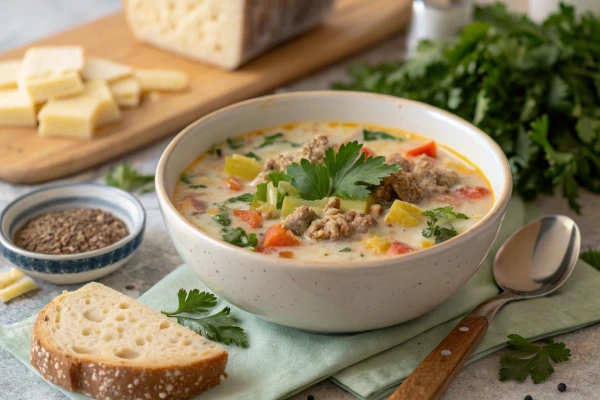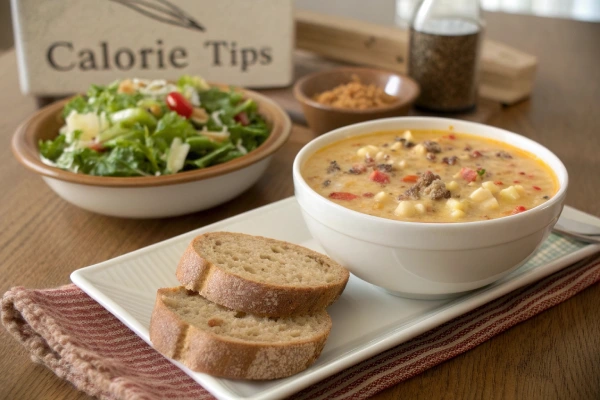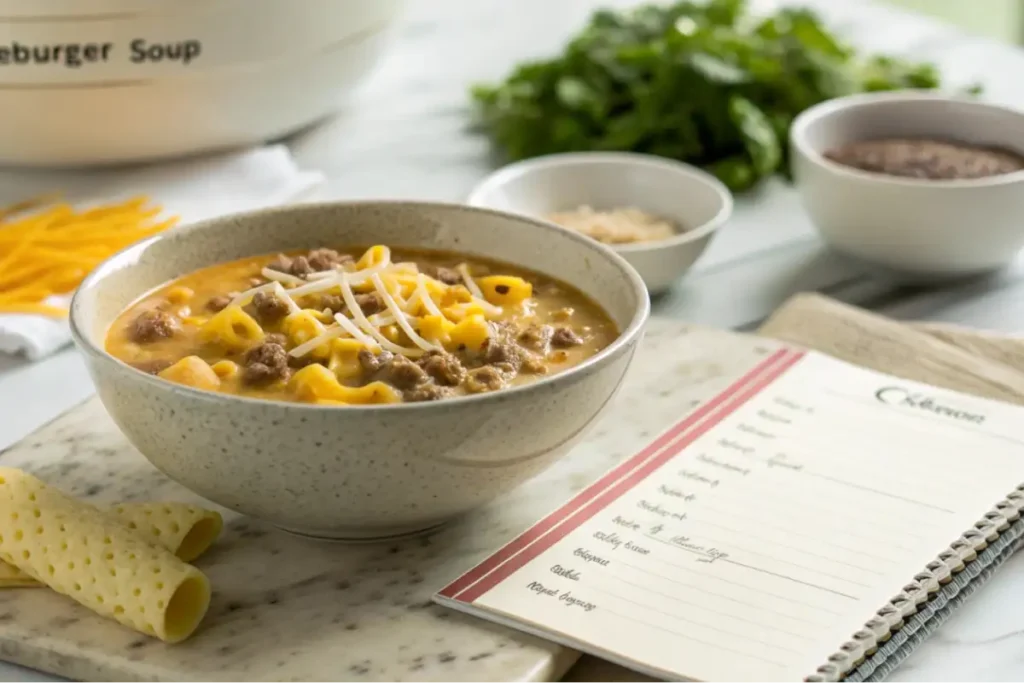How many calories are in a bowl of cheeseburger soup? Cheeseburger soup blends the savory and hearty flavors of a classic cheeseburger to create an inviting, warm dish of soup. However, just like its fast-food ancestors, it’s worth a look at the calorie count before consuming. If you’re tracking calories, adhering to a particular diet, or simply interested in the nutritional value of this dish, knowing the calorie count of this delicious meal is crucial
Table Of Contents
Table of Contents
This article reviews the calories in cheeseburger soup, outlines healthier alternatives, and gives suggestions for enjoying this dish at a lower risk of gaining weight, but without sacrificing taste.
Understanding Cheeseburger Soup Ingredients

The cheeseburger soup usually contains a variety of high-calorie ingredients, making it a delicious and indulgent dish. Let’s look at the key ingredients:
Key Ingredients in Cheeseburger Soup:
- Ground Beef It is often the basis of soup Ground beef is rich in protein, but it can also be fatty, based on the fat content of the meat. So, selecting leaner cuts can reduce calories, without sacrificing taste.
- Cheddar: Cheddar and American cheese are delicious and creamy but also contain substantial energy and calories. Therefore, choosing low-fat cheeses can make the dish lighter.
- Cream and milk: Heavy cream and whole milk provide a creamy texture, but they also can increase calories. Therefore, replacing them with lower-fat alternatives or alternatives that are plant-based could be advantageous.
- Pasta or Potatoes: These carb-heavy ingredients add calories and an extra layer of bulk to soup. Alternatively, cauliflower or zucchini can serve as lower-calorie substitutes.
- Butter is Most often used in sauteing veggies, or to add richness butter is high in calories. To lower calories, you could consider substituting butter with olive oil spray or eliminating it.
- vegetables: The ingredients like carrots as well as celery and onions are rich in fiber and nutrients, yet contain fewer calories. In addition, adding additional vegetables can increase the quantity and nutritional value of a dish without having a significant impact on calories.
Caloric Impact of Add-Ons:
- Toppings such as Bacon as well as Croutons: Additional garnishes can increase calories significantly.
- Condiments (Mustard, Ketchup): They can be used to add flavor and sweetness but can also increase sugar and calories.
Nutritional Breakdown of Cheeseburger Soup
Let’s look at the typical nutrition profile for cheeseburger soup, based on common ingredients:
| Ingredient | Calories per Serving (1 cup) | Macronutrients |
|---|---|---|
| Ground Beef (80/20, 4 oz) | 290 | 23g protein, 0g carbs, 23g fat |
| Cheddar Cheese (1 cup) | 410 | 25g protein, 1g carbs, 34g fat |
| Heavy Cream ( 1/2 cup) | 400 | 3g protein, 3g carbs, 43g fat |
| Potatoes (1 cup, diced) | 116 | 3g protein, 27g carbs, 0g fat |
| Butter (2 Tbsp) | 200 | 0g protein, 0g carbs, 22g fat |
| Vegetables (mixed 1 cup) | 50 | 1g protein, 12g carbs, 0g fat |
Total Estimated Calories per Serving (1 Bowl – Approx. 1.5 cups):
- 700-900 calories (depending on the ingredients used and the size of the portion).
- Macronutrients are high in fats moderate in protein and varying carbs based on the starches that are used.
Average Calorie Count in a Standard Bowl
The size of your portion can greatly impact the amount of calories consumed. An average bowl (1.5 cups) is between 700 to 900 calories with a mix of protein, fats, and carbohydrates.
Key Factors Affecting Calorie Variations:
- Beef Fat Content The 90% of lean beef cuts down on calories as compared to 80/20 ground beef. In addition, draining fat after cooking results in an additional reduction in calories.
- Cheese Options: Low-fat cheeses or smaller portions reduce calories. Additionally, sharp cheeses provide more flavor, allowing you to use fewer calories but still enjoy the taste.
- Cream substitutes The substitution of heavy cream in place of milk Greek yogurt can reduce calories. Equally, almond milk that is not sweetened has a rich texture and less calories.
- Vegetables and Potato. Carb Ratio Incorporating more vegetables and cutting down on potatoes reduces calories and carbs overall. In addition, ingredients such as spinach, zucchini, or cauliflower can increase the volume of the dish while remaining light.
If you are looking to improve your reduction of calories, a change in ingredients could make a huge difference as explained in the following section.
Healthier Variations of Cheeseburger Soup

Are you craving a bowl of cheeseburger soup but not guilt? Here are a few healthier alternatives to test:
Low-Fat Options:
- Utilize ground turkey, or even chicken in place of beef, to reduce calories and fat.
- Alternate thick cream with dairy products that are low in fat as well as non-sweetened almond milk to get a lighter texture.
- Choose low-fat cheese or choose less sharp cheddar to get an intense flavor with no calories.
High-Protein, Low-Carb Options:
- Create your food keto-friendly by avoiding potatoes and substituting cauliflower’s florets to replace them.
- To increase protein, add lean meats and cut down on cream.
Vegetarian Alternatives:
- Substitute ground meat with vegetable-based chunks and lentils.
- Make use of coconut milk as well as nutritional yeast to create a vegan-friendly, creamy texture.
Flavor Boosters Without Calories:
- Include spices such as garlic powder, paprika as well as black pepper instead of using butter and cheese to add flavor.
- Mix in a splash of hot sauce or mustard to give it a tang without the addition of fat.
Ingredients That Affect the Calorie Count
Knowing which ingredients have a significant impact on the calories in soups made with cheese can aid you in making better food decisions.
1. Cheese and Cream – Calorie Boosters
- Cheddar Cheese (1 Cup): Approximately 400 calories mostly from fat.
- Heavy Cream ( 1/2 cup): Around 400 calories which contributes to a smooth texture, but also contains significant calories.
- milk (1 Cup): Whole milk contains 150 calories and skim milk provides an alternative that is lighter with just 90 calories.
2. Ground Beef – Protein and Fat Source
- 80/20 Ground Beef (4 4 oz): Contains approximately 300 calories and a fat content of 23 grams.
- 90/10: Lean Ground Beef (4 8 oz): A leaner option that has more than 200 calories and just eleven grams of fat.
- Turkey and Chicken (4 4 oz): Lower-fat alternatives that provide around 160 to 180 calories and lower saturated fat.
3. Vegetables – Low-Calorie Fillers
Vegetables such as celery, carrots, and onions are rich in nutrients and fiber, without raising calories:
- Carrots (1 cup): 50 calories.
- Celery (1 cup): 15 calories.
- Onions (1 cup): 64 calories.
4. Carbohydrates – Starchy Additions
- potatoes (1 1 cup): 116 calories and 27g of carbs.
- Cauliflower (1 cup): A low-carb alternative with 250 calories as well as five grams of carbohydrates.
5. Extras – Hidden Calories
- Butter (2 tbsp): 200 calories mostly from fat.
- Bacon or Croutons Bits (1 Tbsp): 30-50 calories per serving, but often missed.
Portion Size and Serving Suggestions

Portion size plays a huge role in calorie management. Here’s how to make sure you’re not consuming too much:
Standard Serving Size:
- Cup (8 8 oz): Around 500-600 calories according to the ingredients.
- Bowl (1.5 cups): Between 700-900 calories.
Tips for Controlling Portions:
- Utilize Measuring Tools Take measurements of ingredients before adding them to avoid overestimating portions.
- Pre-Portion Food Servings: Ladle soup into smaller bowls, rather than eating straight out of the bowl.
- Combine with a Side Salad: A light side dish can create a balanced and healthy meal without adding additional calories.
- Beware of Overloaded Toppings: Skip high-calorie extras like cheese, croutons or bacon bits.
Tips for Reducing Calories Without Sacrificing Flavor
Are you looking to enjoy soup with cheeseburgers without guilt? Here are some practical suggestions for reducing calories:
- Lean Protein Options: Replace 80/20 ground beef with 90/10 ground turkey, chicken, or. Additionally, you should consider removing any excess fat you have left after cooking to further cut down on calories.
- Low-Fat Dairy Options: Use reduced-fat cheese or a smaller amount of cheddar sharp for flavor. In the same way, replace heavy cream with Greek yogurt or low-fat milk. You can also use unsweetened almond milk to preserve the creaminess but without the calories.
- Alternate Carbs Switch potatoes with cauliflower to decrease calories and carbs. Additionally, add additional veggies like spinach or zucchini to bulk up your diet but without the calories.
- Flavor Enhancers without Calories: Incorporate garlic powder and black pepper. You can also add paprika and mustard to create depth without sugar or fat. Also, adding a little Worcestershire sauce or hot sauce can increase the flavor of the dish.
- cooking methods: Avoid frying ingredients in butter. Instead, make use of olive oil spray to saute vegetables. Additionally, consider the slow cooker or the Instant Pot to allow flavors to develop without adding fats.
By incorporating these strategies, you can reduce how many calories are in a bowl of cheeseburger soup while still enjoying the full, rich flavors of the dish.
Is Cheeseburger Soup Healthy?
Pros:
- Protein-rich: Great for muscle recovery and weight loss.
- High in Nutrients Offers vitamins and mineral content from veggies.
- Comfort Food Appeal: Offers indulgence in moderation.
Cons:
- A high content of Calories and fat: Can quickly exceed daily limits of calories if portions aren’t properly controlled.
- Sodium Beware: Store-bought versions may contain too much salt.
- Carb-heavy Options: Potatoes and pasta may make it unsuitable for low-carb diets.
Final Verdict:
Soups with cheeseburgers can form an element in a healthy diet it is consumed in moderation or made with healthy ingredients.
High-Protein and Low-Carb Versions of Cheeseburger Soup
For those who are on keto, low-carb, or high-protein diets, the cheeseburger soup can be easily altered to meet your nutritional needs.
- Keto-friendly Cheeseburger Soup Replace potatoes using Cauliflower: Cauliflower keeps the consistency similar, while dramatically decreasing carbs. Additionally, you can use thick cream as well as cream cheese to keep its richness, but without adding carbohydrates.
- Add extra protein Use ground beef which is lean turkey, and shreds of chicken to make protein-rich servings. Additionally, stay clear of thickening agents such as flour and instead use creamy cheeses or xanthan Gum to create a thicker texture when required.
Diet to Keto Version (1 cup):
- Calories: 450-500
- Protein: 35g
- Fat: 35g
- Carbs: 6-8g
High-Protein Options:
- High-Protein Option: Use 93% lean ground turkey or chicken to get more protein and less fat. Additionally, add additional greens like mushrooms and spinach to provide fiber and nutrients. Then, top your dish off with Greek yogurt in place of sour cream for added protein.
Nutrition for High-Protein Version (1 cup):
- Calories: 350-400
- Protein: 40g
- Fat: 12-15g
- Carbs: 10-15g
Vegetarian and Vegan Alternatives
Are you craving a delicious cheeseburger soup but without dairy or meat? Consider these options:
- Vegetarian Cheeseburger Soup substitutes ground meat with chickpeas, lentils, or black beans to get protein. Also, you can substitute vegetable broth for beef or chicken broth. Include plenty of vegetables such as bell peppers, zucchini as well as mushrooms to add bulk and a delicious flavor.
- Vegan Cheeseburger Soup You can substitute meat for vegan crumbles made from plant matter or tempeh. Equally, make use of cashew or coconut milk for a rich texture. Substitute cheese using nutritional yeast as well as alternative cheeses that are vegan.
Vegan Nutrition Per Cup:
- Calories: 250-350
- Protein: 15-20g
- Fat: 10-15g
- Carbs: 20-25g
Are you looking for suggestions to accompany this soup with cheese, then you might be interested in this article on what’s a suitable accompaniment to the cheeseburger soup. It offers many pairing ideas to enhance the flavor and balance the flavor of your dinner.
FAQs About How Many Calories Are in A Bowl Of Cheeseburger Soup
How many calories are in cheeseburger soup?
A standard serving of cheeseburger soup (approximately 1 cup) contains between 340 to 614 calories, depending on the recipe and ingredients used
How many calories are in a bowl of homemade hamburger soup?
Homemade hamburger soup typically contains around 300 to 500 calories per serving, varying based on the ingredients and portion sizes.
How many calories are in a bowl of cheese soup?
A bowl of cheese soup generally contains approximately 400 to 600 calories, influenced by the type of cheese and other ingredients used.
How many calories are in a cheeseburger bowl?
The calorie content of a cheeseburger bowl varies widely depending on its ingredients and portion size. For example, a cheeseburger bowl from Tattooed Chef contains 430 calories per serving. Similarly, a cheeseburger bowl from Fit-Flavors provides 540 calories per serving
Final Thoughts on Cheeseburger Soup Calories
Cheeseburger soup is a tasty and hearty meal that can be incorporated into many diets with the proper modifications. It doesn’t matter if you’re enjoying it as a comfort food or modifying it to fit into a healthier lifestyle, knowing how many calories are in a bowl of cheeseburger soup can help you make better decisions.
While a standard bowl is between 700 and 900 calories, a variety of alternatives such as lean meats, low-fat dairy, and additional vegetables can dramatically cut down on this number. Additionally, combining it with a healthy lifestyle will ensure balance and let you enjoy this meal guilt-free.
Looking for more tasty recipes and cooking inspiration? Connect with us on Facebook at Dashtasty and become part of our foodie family.




2 thoughts on “How Many Calories Are in a Bowl of Cheeseburger Soup? A Nutritional Breakdown”